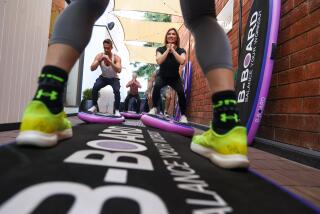Beach towel snaps into workout regimen
- Share via
It may finally be summer in Southern California, but some of us aren’t quite ready for swimsuits and sand. So grab a towel, head to the beach and … exercise. Yes, goofy as it sounds, that beach towel comes in handy for a quick workout circuit that taxes the cardiovascular system and tones muscles.
New York-based fitness consultant and personal trainer Sara Haley devised this beach towel workout out of necessity — both she and her clients travel quite a bit, and gym equipment is often nonexistent. “A circuit is always going to be your most efficient way of working out,” she says, “because it gets everything — cardio and strength. If you have time to do it once, that’s great, or you can go through it three or four times and have a great 20-minute workout.”
But a beach towel? Why not — use what you’ve got.
Instead of counting reps and sets, Haley advises to go by time. People who haven’t exercised in a while can start with 15-second intervals, then progress to 30 seconds, then one minute. If doing multiple sets of individual exercises to make a longer circuit, don’t rest too much in between — just a minute or so.
Doing these exercises at the beach on sand will add a degree of difficulty. Because the surface is unstable, core muscles have to work harder to keep the body balanced. Wet sand increases the difficulty because it’s easier to sink into and harder to get out of. But this workout can be done anywhere: a gym, a park, a backyard.
And it doesn’t always have to be done solo: “It’s fun to do these with a partner,” Haley says, “and make it a little bit of a contest.”
Tip toe runs: Run back and forth over the towel while on the balls of your feet. This works the calves and quadriceps, and maintaining balance while running works the core muscles. To make it a little easier, you can run toe-heel, toe-heel.
For the first half, start with the left foot, going left-right across the towel and left-right back down. Halfway through the exercise, switch and start with the right foot. On this exercise, go for speed — the faster you move, the more calories you’ll burn and the better your agility will be.
Moving tree: Stand on one leg and bring the other leg up and bend it so the foot is resting above or below the knee, but not directly on the knee. The bent leg is extended out to the side. Hold the towel above the head in both hands and think about pulling the towel apart, engaging the back muscles and retracting the shoulders — this is especially good if you sit at a desk all day.
Reach the torso toward the bent leg, going up and over — lift the torso and keep it long. Don’t collapse into your rib cage. The hips stay centered and do not move. Squeeze the glutes as you reach, then slowly come back to the starting position. If you’re doing this in sand, it’s OK to grip the sand with your toes to maintain your balance. After 30 seconds, switch legs and repeat the exercise.
To modify this exercise, bend one leg and place just the toe on the floor, with the heel up. Shorten the range of motion on the bend until your core muscles are stronger and your balance has improved.
Hippety-hop: Place the towel vertically to the right of you. Standing with feet together, bend the knees and tuck the arms back. Hop over the towel, allowing the arms to swing up; and land toe-heel, with soft knees. Don’t land on flat feet — even on sand it’s quite an impact. This is a great cardiovascular challenge, and you can make it more difficult by picking up the pace and kicking your feet back as you hop.
The idea is to take off as quickly as you can after you land, allowing the muscles to engage. This is also a plyometric exercise, a dynamic move that trains fast-twitch muscles and also helps build bone density. This exercise also works the outer thighs.
Triceps pulse: Stand with feet shoulder-width apart and bend the knees slightly. Bend forward at the waist, making sure the head is aligned with the spine. Hold the towel with both hands behind your back, arms straight but not locked at the elbows, palms facing away from the body.
Raise the arms a few inches and do several little pulses, keeping the shoulders square and focusing on the triceps muscles in the back of the arm. Complete the range of motion by bringing the arms back down to the starting position. When you raise the arms, don’t go so high that you feel a strain or pinch in the shoulders.


